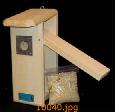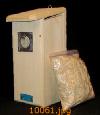
   |
 |
|
|
Woodpecker Houses
|
|||||||||||||||||||||||||||||||||||||||||||||||||||||||||||||||||||||
 Coveside Conservation Windowsill Feeder Natural
Coveside Conservation Windowsill Feeder Natural
Coveside Conservation windowsill feeders will give you plenty of up close bird viewing from the comfort of your home. The feeders are designed to sit on your windowsill and are held in place by easy to use spring set dowels that fit securely in the screen window tracks. •Open Back and acrylic top gives you plenty of great viewing • Fits double hung windows up to 38" wide • Perforated metal screen feeding platform for proper drainage. • Clean and fill from the inside of your house |
 Coveside Downy Woodpecker House
Coveside Downy Woodpecker House
America's smallest woodpecker, the Downy is a
backyard favorite. They are friendly little birds that
enjoy being around people. Since Downys tend to use nest boxes in the winter as
roosts to escape the cold, one might want to put up a house in the fall. Comes
standard with slate squirrel guard and wood chips. |
 Coveside Northern Flicker House
Coveside Northern Flicker House
The Northern Flicker is a woodpecker that utilizes a bird house quite readily. If there is a problem with a flicker pecking a hole in a building, fill the this house with wood chips and position it over the unwanted excavation to provide a more suitable nesting location. RANGE: Resides throughout the U.S. and Canada. HABITAT: Prefers open country with trees, parks and large gardens; especially in or at the edge of open woods.. (17-3/4"h x 9-1/4"w x 11"d) |
 Coveside Slate Squirrel Guard
Coveside Slate Squirrel Guard
This guard is used with the following nesting houses: Window Nest Box, Chickadee, Nuthatch, Titmouse, House Wren, all Bluebird Houses, Saw-Whet Owl and Kestrel. This guard will protect the box from chewing squirrels. |
 Coveside Three Woodpecker House
Coveside Three Woodpecker House
Only a few varieties of woodpeckers will live in a man-made box, but the Hairy, Red-headed and Red-bellied Woodpeckers regularly do so. This house comes with wood chips and a slate predator guard to keep squirrels from enlarging the entrance hole. RANGE: Resides throughout the U.S. and Canada, and north to Alaska. Some northern birds move south for the winter. HABITAT: Lives in or at the edge of open woods, prefering deciduous forests. (17-1/2"h x 7-1/2"w x 9-3/4"d) |
 Coveside Wood Chips Nesting Material
Coveside Wood Chips Nesting MaterialNesting Material. Gallon size. |
|
Ads by Google |

Home
Page |
Product Review Page | Help
 Woodside Gardens
The Registry of Nature Habitats
Woodside Gardens
The Registry of Nature Habitats 
 1999 -
1999 -
All Rights Reserved
Last Updated: